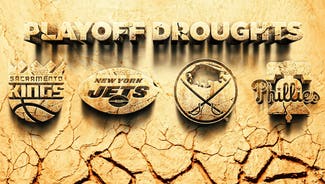
Does fighting still belong in the NHL?
In recent weeks the National Hockey League has garnered attention in the sports world, though it's not the kind league officials would prefer.
Since late January there's been an uptick in fights, most notably two games featuring multiple-player brawls between the New York Islanders and Pittsburgh Penguins, plus two February tilts featuring the Boston Bruins — one against the Dallas Stars and one versus the Montreal Canadiens.
Even the goaltenders got involved, with Pittsburgh's Brent Johnson sidelining the Islanders’ Rick DiPietro for weeks with facial injuries in a one-punch knockdown back on Jan. 25, a reluctant dance between the Bruins' Tim Thomas and Canadiens Carey Price — who are not only off-ice friends but also two of the league’s top netminders — followed by the Feb. 11 rematch between the Penguins and Islanders which again saw Johnson get involved, albeit this time in self-defense against Islanders center Michael Haley.
The latest Penguins-Islanders brawl — which generated 346 minutes in penalties, including 15 fighting majors, 20 misconducts and 10 player ejections — resulted in suspensions for Penguins forward Eric Godard (10 games for leaving the bench to aid Johnson) and the Islanders’ Trevor Gillies and Matt Martin (nine and four games respectively, for deliberate attempts to injure Penguins Eric Tangradi and Max Talbot).
Penguins owner and Hockey Hall of Famer Mario Lemieux criticized the penalties received by Gillies and Martin as insufficient and called on the league to improve player safety.
His comments drew both praise and scorn from around the NHL, though league brass remained silent on the matter other than issuing a terse statement declaring they'd dealt appropriately with the Islanders and considered the matter closed.
These brawls have once again given rise to evaluation of the role of fighting in professional hockey.
Critics argue there's no room for it in today's modern game, pointing out how little it figures into playoff hockey (when “enforcers” are often benched in favor of more skilled players), calling it an unnecessary sideshow which detracts from the game's blend of speed, skill and toughness, and pointing out the contradiction that a league which markets itself as “family friendly” allows such thuggish behavior.
On the other side of the debate are those who point out fighting has always been a part of the game, blame the “instigator” rule (which awards an extra penalty for players starting fights) for both limiting players from policing themselves as well as the rise of dirty play like blindside hits to the head, and claim fighting provides an additional measure of entertainment to the game.
Ultimately it's that latter point — the entertainment factor — which explains why fighting remains part of the NHL product.
While the NHL game has come a long way to clean up the game since its bad old days of the 1970s and early 1980s when “line brawls” (fights involving all on-ice players) and bench-clearing donnybrooks were seemingly the norm, the inescapable fact remains that fights provide an additional measure of excitement for hockey fans.
One need only watch the reaction of fans in the arena when a fight breaks out. They rise to their feet, cheering on the combatants (especially the hometown one) and enthusiastically applaud when the scrap is over. Indeed, fans will boo the on-ice officials if they jump in and break up a potential fight before it starts. Most fans who bring their children to the games get wrapped up in the action and do little, if anything, to prevent their kids from watching fights, who often get as caught up in the excitement of two — or more — players pummelling each other with their fists as their parents.
If a majority of NHL fans were to express disgust in fighting, to the point where it would adversely affect ticket sales and TV ratings, the NHL would implement an outright ban in short order.
But that hasn't happened, and probably never will, unless hockey fans undergo a cultural shift of opinion toward gratuitous violence in the sport.
That's not to suggest, however, the league might consider easing up on their current rules for penalizing fights.
League brass frowns upon the brawls like those between the Penguins and Islanders, and the Bruins and Canadiens. A one-on-one scrap between two evenly matched combatants which draws incidental five-minute fighting majors is one thing, provided there aren't too many of those in one game, especially involving the same combatants. Multiple fights breaking out at once which even draw in the goaltenders is another matter.
The last thing the NHL wants is for its product to return to its wilder days, when it became the punchline for a Rodney Dangerfield joke (“I went to a fight the other night and a hockey game broke out.”).
The role of fighting as a main selling point for professional hockey remains a topic of debate. Some will argue it helps draw in more fans, while others claim it merely appeals to already die-hard hockey fans, does little if anything to attract new fans, and serves no purpose in the modern game.
The NHL has implemented rules to clamp down on the worst aspects of fighting, but unless the majority of its fans express distaste for any type of fighting don't expect to see it abolished.


